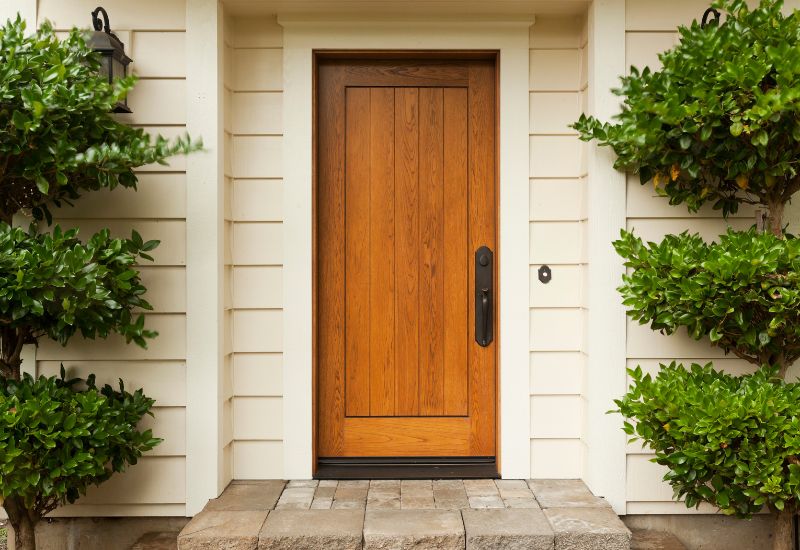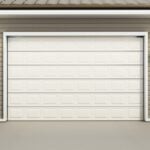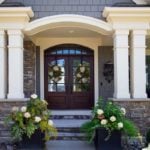
Not all doors are created equal. Steel doors are durable but can dent and rust. Wooden doors are made of high-end materials but require more maintenance.
Fiberglass doors are an alternative that takes elements from both. So let’s look at the pros and cons of fiberglass entry doors.
- What are Fiberglass Entry Doors?
- Pros of Fiberglass Entry Doors
- Cons of Fiberglass Entry Doors
- Other Options
- FAQs about Fiberglass Doors
- Closing the Door
What are Fiberglass Entry Doors?

Fiberglass entry doors are meant to mimic the feel and look of wood doors without all the risks. Their frames are made of wood or high-strength composite materials. Their cores are made of polyurethane for insulation and soundproofing. Their exterior is made of compression-molded fiberglass.
Pros of Fiberglass Entry Doors
Versatility
Fiberglass exterior doors can be compression molded into almost any shape, allowing them to match the look and feel of your home, increasing its curb appeal.
Durable
Fiberglass doors are more durable than steel or wood doors, as they never rot, warp, or rust, giving them a lifespan of several decades. Additionally, they hold up against dents, scratches, insects, and fire better than most, meaning they need less maintenance. The worst that can happen is they need to be painted.
Energy Efficient
Fiberglass doors are more energy efficient than wood or steel, thanks to their foam cores. They reduce heat transfer, making your house warmer in winter and cooler in summer, leading to reduced energy waste and lower energy bills.
Safe
Fiberglass doors can be outfitted with double or triple-pane glass, which is harder to shatter than single-pane windows. You can also add a locking door system to them for additional security.
Have Warranties
Because of their versatility and durability, fiberglass doors come with a warranty, which makes them attractive to homeowners.
Cons of Fiberglass Entry Doors
Expensive
Fiberglass doors can take a bite out of your budget. On average, fiberglass front doors cost between $800 and $2,500.
Difficult to Fit Odd Spaces
Despite their versatility, fiberglass doors are hard to trim to fit smaller-size frames. If you have such a frame, consider a different type of door.
Tough Installation
Fiberglass doors are not DIY projects. Installing such a door means installing the entire entry system with it, as they come as a full unit with the frame. Because of this, you need to hire a professional to install these doors.
Fiberglass vs. Other Kinds
Steel Doors
As you would expect, steel entry doors are very sturdy. They won’t rot, warp, or swell under extreme weather conditions and are low maintenance. Additionally, steel doors are less expensive than fiberglass doors.
However, steel doors are vulnerable to rusting, scratches, or dents, and if they do get damaged, steel doors are harder to repair. Also, steel doors aren’t as well insulated as fiberglass doors. Plus, they aren’t the most aesthetically pleasing to look at.
Wood Doors
Wood front doors have a natural beauty, warmth, and authenticity, which makes them very attractive. Additionally, they can be sanded or easily repaired. Scratches and dents hide in the wooden texture.
However, wood doors aren’t as energy efficient as fiberglass ones, and they can swell because they absorb moisture from the air. Generally, they need more maintenance than fiberglass and steel doors and necessitate a portico (a covered entrance to a home supported by decorative columns) to protect them from the elements.
FAQs about Fiberglass Doors
You can, but it isn’t necessary. Fiberglass doors are built to stand up to harsh weather and other damaging effects. However, there are benefits to combining fiberglass doors with storm doors:
• Enhanced protection. Extra protection can be helpful if you live in an area with harsh weather conditions. Storm doors keep your fiberglass door in better shape for extended periods.
• Extra energy efficiency. Storm doors form a pocket of air between your entry door and outside temperatures, giving your house an extra layer of insulation.
• Natural light. If you have a storm door, you can open your fiberglass door during the warmer months to give your entryway some natural light while still having an extra door to keep insects at bay.
Despite their stronger resistance to weathering than wood or steel doors, fiberglass doors can fade due to prolonged exposure to sunlight. If this happens, you can patch the stain with gel. Make sure to clean your door properly with a non-sudsing cleaner before you do so.
Yes. Blinds provide shade, have no cords, and are behind glass, keeping the door clean. Additionally, blinds will fit over your existing fiberglass trim without any modifications, making them easy to install.
Closing the Door
There are numerous factors involved in picking a new door, such as functionality, size, and price. Fiberglass doors are no different, and understanding the advantages and disadvantages of fiberglass doors will help you make an informed decision on whether or not they suit you.
If you decide a fiberglass door is right for you, contact one of our home improvement specialists and we’ll send you a confirmation.
Main Photo by: Stephen B Calvert Clariosophic / Wikimedia Commons / CC BY-SA 3.0




